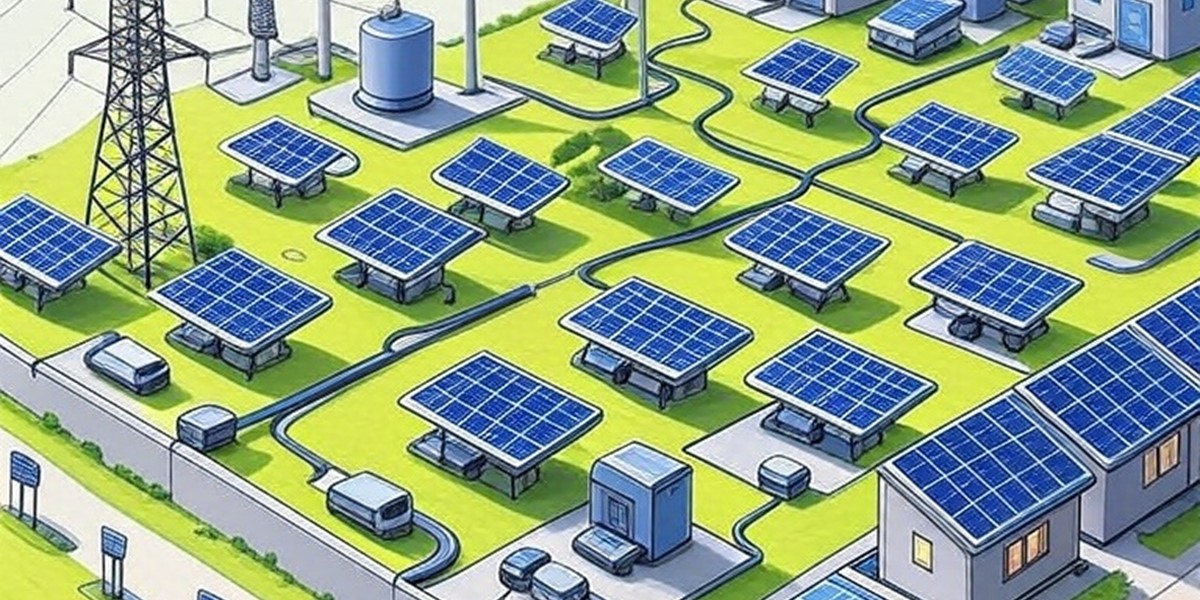Philippe Van Loock holds a Master's degree in Applied Economics (Katholieke Universiteit Leuven). He also holds the Belgian ABAF-BVFA Financial Analyst accreditation and is a certified European Financial Analyst (CEFA). After his studies, Philippe gained 20 years of experience at a large Belgian Private Bank as Financial Analyst and more recently as Portfolio Manager of an impact fund. Philippe joined Econopolis Wealth Management on April 1st, 2022.
Virtual Power Plants: The virtual powerhouse reshaping energy supply

The insatiable hunger for electricity
The world stands on the brink of an unprecedented surge in electricity demand. Buildings are becoming increasingly energy-intensive due to smart technology, heating, and cooling systems that are rapidly electrifying. On top of that, the explosive growth of data centers and artificial intelligence is driving demand further. According to the International Energy Agency (IEA), electricity consumption from data centers and AI is expected to triple by 2030, accounting for over 6% of global demand. In the United States alone, data centers are projected to consume nearly as much electricity by 2030 as all residential households in Texas combined.
How do we address this? The traditional answer: more production capacity through gas plants or nuclear energy, especially for large-scale projects. But this model is slow, capital-intensive, and often controversial. Renewable energy is growing rapidly but comes with its own challenge: variability. Solar and wind energy are not always available when demand peaks. This is where, alongside the use of modular engine plants (e.g., from Wärtsilä), a new player emerges: Virtual Power Plants (VPPs).
What is a Virtual Power Plant?
A Virtual Power Plant (VPP) is not a physical power station. It is a smart digital platform that aggregates and controls hundreds, thousands, or even hundreds of thousands of small energy sources, operating as if they were a single large power plant. Think of solar panels on homes, home batteries, electric vehicles, heat pumps, and even industrial installations.
Using algorithms and real-time data, these distributed resources are coordinated to:
- Deliver power when demand peaks,
- Store excess power when supply is abundant,
- And keep the grid balanced by quickly ramping up or down.
A VPP is thus the digital conductor of an orchestra of thousands of small players, acting together as one powerful, flexible energy source.
“Where once a single massive chimney stood, now thousands of solar panels and batteries form a virtual power plant.”
What does a VPP do in Practice?
The core function of a VPP is balancing. Electricity grids must always be perfectly balanced: supply and demand must align second by second. When this balance falters, grid instabilities or even blackouts can occur. VPPs help maintain this balance by:
- Demand response: Intelligently shifting consumption (e.g., temporarily pausing supermarket cooling systems).
- Flexible supply: Allowing batteries or electric vehicles to feed power back to the grid.
- Renewable integration: Storing surplus solar and wind energy and releasing it later.
The result? Less reliance on expensive, polluting peaking plants.
The players in the field
The VPP ecosystem is diverse and growing rapidly:
- Technology companies: Tesla (with its Powerwall and car batteries) and Sonnen (Germany) are pioneers.
- Utilities and energy companies: EDF (France), Enel (Italy), and NextEra Energy (US) are integrating VPPs as a strategic part of their portfolios.
- Software platforms: Companies like AutoGrid, Kiwi Power, and Voltus provide the digital backbone for coordination.
- Governments and grid operators: They are promoting VPPs through regulations and pilot programs, such as California’s DSGS program (Demand Side Grid Support Program) and the European Clean Energy Package rules.
Investments in VPP-related companies are surging. BloombergNEF estimates that the global market for demand response and VPPs could be worth over 50 billion dollar by 2030.
Where are VPP’s already active?
United States
The US is a leader thanks to strong incentives and well-developed programs. In California, VPPs connect tens of thousands of households with Tesla Powerwalls. In Texas, during the 2023 heatwaves, VPPs proved their worth by preventing blackouts through massive power delivery.
Europe
Germany is a pioneer, driven by widespread adoption of solar panels and batteries. Companies like Sonnen manage large virtual power plants with hundreds of thousands of small installations. The UK and France are also integrating VPPs into their capacity markets.
Asia
Japan has heavily focused on VPPs since the Fukushima disaster. Australia is a prime example with the Tesla VPP project in South Australia, where tens of thousands of homes with Powerwalls collectively form a power plant with hundreds of megawatts of capacity.
“From California to Canberra: virtual power plants are becoming a tangible reality.”
Where are we now?
Today, VPPs are still in an early stage of development, but their growth trajectory is steep. According to Wood Mackenzie, global VPP capacity could exceed 150 GW by 2030—equivalent to 150 nuclear power plants. This is good news, as this flexibility is crucial for accelerating the energy transition.
Institutional investors are showing increasing interest because VPPs are asset-light (no large physical construction required), rapidly scalable, and provide a direct solution to grid congestion. The investment case combines growth potential with societal relevance.
Future outlook: from experiment to core component
The future of VPPs looks promising:
- Integration with AI: Advanced algorithms will predict and manage supply and demand even more intelligently.
- New markets: Electric vehicles will be widely used as “rolling batteries,” potentially providing over 30 TWh of flexible storage globally by 2030.
- Regulation: Policymakers are accelerating adoption by opening markets to distributed resources.
- Financial innovation: VPPs are increasingly traded on energy markets as if they were conventional power plants.
However, challenges remain: cybersecurity, lagging regulations, and creating sufficient incentives for consumers to participate.
At Econopolis, our fund managers keep a close eye on developments, seeking the perfect balance between opportunities and challenges in their investments.
The Bigger Picture: How do we truly meet rising demand?
The growing demand for electricity cannot be met with a single solution. It will require a mix:
- Nuclear energy: Provides stable baseload but has long construction times and high capital costs.
- Gas plants: Quickly deployable but CO₂-intensive and not future-proof.
- Renewable energy: Cheap and clean but variable.
- Storage and VPPs: Enable the management of variability and prevent blackouts.
“The power plant of the future has no walls, only millions of tiny switches.”
Conclusion: An investment opportunity in the making
Electricity demand will only grow in the coming decades. Traditional solutions fall short in flexibility, speed, and sustainability. VPPs fill this gap. They are digital, scalable, and perfectly aligned with the megatrends of electrification and decarbonization.
For equity investors, VPPs offer a unique opportunity: a growth market that delivers both economic returns and societal value. The question is not whether VPPs will reshape the energy market, but when — and who will seize the opportunity in time.
The power plant of the 21st century no longer sits on the edge of town with a plume of smoke. It is spread across our rooftops, in our cars, and in our batteries—invisibly connected by software, but tangible in its impact.
